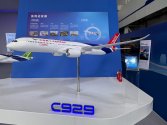lcloo
Major
I think if C939 turn up to be larger aircraft than C929, many of these would be freighter variant, though passenger variant would still be more numerous than the cargo planes variant.
Since C939 is presumely still in concept fesibility study stage, it's final design could be very different from our vision of current planeform of a cylindrical fuselage with wings attached. It may take 15 to 20 years to materialise and if Chinese aircraft designers become bold in their ideas, we might see a subsonic flying wing body or a supersonic passenger aircraft with the designation of C939 attached to it.
As for whether there is a demand for such a niche aircraft, that will depnds on what the World economy will be in 15 to 20 years (year 2039 to 2044). If South Africa, Brazil and other countries located at the far side of the World becomes richer economically then they might need direct flights to and from China. And if political relationship between China and US, and also the West becomes warmer 20 years from now, a large aircraft type would be in demand.
And a feasibility study does not mean it will progress into a real commercial product. Nevertheless making a feasibility study will benefit COMAC. And having making some R&D in advance, COMAC would not miss the train if the opportonity arise, plus some of the R&D for the supposely C939 may also be apply for latest C919 and C929 variants.
Since C939 is presumely still in concept fesibility study stage, it's final design could be very different from our vision of current planeform of a cylindrical fuselage with wings attached. It may take 15 to 20 years to materialise and if Chinese aircraft designers become bold in their ideas, we might see a subsonic flying wing body or a supersonic passenger aircraft with the designation of C939 attached to it.
As for whether there is a demand for such a niche aircraft, that will depnds on what the World economy will be in 15 to 20 years (year 2039 to 2044). If South Africa, Brazil and other countries located at the far side of the World becomes richer economically then they might need direct flights to and from China. And if political relationship between China and US, and also the West becomes warmer 20 years from now, a large aircraft type would be in demand.
And a feasibility study does not mean it will progress into a real commercial product. Nevertheless making a feasibility study will benefit COMAC. And having making some R&D in advance, COMAC would not miss the train if the opportonity arise, plus some of the R&D for the supposely C939 may also be apply for latest C919 and C929 variants.


